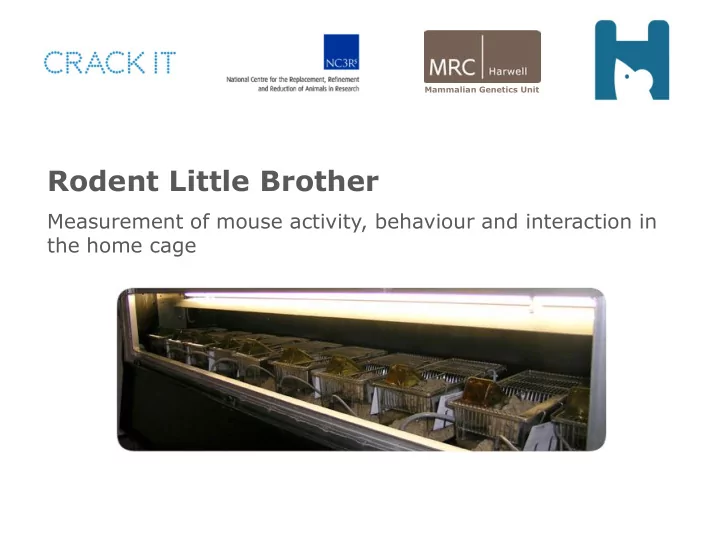

Mammalian Genetics Unit Rodent Little Brother Measurement of mouse activity, behaviour and interaction in the home cage
Standard behavioural tests in mice • Never designed for mice in the first place Mice and rats, different physiologies Species behaviours are quite different Tests don’t measure natural behaviours • Laborious and invasive Informative screens often take weeks of animal training Often require constant user monitoring Many tests involve invasive procedures • Too much variability User dependent Handling itself introduces variability Often dependent on subjective scoring systems • Affects animal welfare Animals continually being moved to unfamiliar environments
Standard behavioural monitoring
Efforts to develop more efficient tests • Home cage testing • Refinement that improves welfare of animals • Less handling and user interference • Robust • More species-relevant behaviours • Monitors or makes use of natural mouse behaviour • Better performance • Automated • Less subjective scoring • Less laborious
Desirable scenario Activity Arousal Social Behaviors Tremors/seizures Avoidance Behaviors Aggressive Behaviors Stereotypies Eating/drinking/rearing
Objectives – developments of current systems to enable…. • True home-cage monitoring • Tracking more than one animal at close quarters • Software that is intuitive and flexible
3Rs Benefits • Overcomes the need to move animals to unfamiliar environment • Animals need not be singly housed for testing • Reduced variability in data means smaller cohorts for testing, fewer animals • Opportunity to identify early-onset indicators of disease progression in mouse models • Earlier humane endpoints and interventions can be established • Opportunity for the cage-monitoring system to be incorporated universally
Key Deliverables – Phase 1 • Technology to monitor remotely the position (X,Y,Z) of two or more mice in the home cage • Better definition and assessment of behaviour and movement including rearing • Less subjective scoring • Technology that will distinguish animals in extreme close quarters • Could be a combination of chip- based and tracking technologies • More detailed and accurate information in social behaviour monitoring studies
Key Deliverables – Phase 2 • A key component of Rodent Little Brother will be to develop and validate software tools to measure initially • Activity • Social interaction • Aggressive and avoidance behaviours • Arousal state • Tremors and/or seizures • Software tools should be flexible enough to incorporate new algorithms to assess other behaviours • Intermediate priority behaviours such as feeding/drinking, grooming, mating behaviour, climbing, nest building, juvenile play • Low priority behaviours that may ultimately enhance the interpretation of behavioural data (eg assessment of apparent changes in body size and assessment of direction of gaze would both be key in interpretation of social and novel object interactions) • Software should be easy to use
In Kind Contributions • MRC Harwell has been involved in driving many international mouse behavioural phenotyping projects • Standard test batteries • Development of new automated tests • Incorporation of new tests into test batteries, determination of test order effects • Cross-laboratory evaluation • MRC Harwell houses multiple inbred strains and mutant lines for test validation • Inbred strain comparisons extremely useful to identify informative baseline behavioural parameters • Many mutant models of human neurological and psychiatric disease to assess validity of parameters being measured • MRC Harwell can • Provide advice and guidance on setup of home cages etc • Compare and validate set-up by comparing new set-ups with standard phenotype assessment
Validation - Activity over 24 hrs in home cage, strain comparisons 140 B6J C3HH B6N C3PDE Distance (m) 0 3 month 6 month 9 month 12 month 18 month 2500 B6J C3HH B6N C3PDE Distance (m) 0 3 month 6 month 9 month 12 month 18 month
Contact Details • Pat Nolan, MRC Harwell, p.nolan@har.mrc.ac.uk • Sara Wells, MRC Harwell, s.wells@har.mrc.ac.uk • Abraham Acevedo, MRC Harwell, a.acevedo@har.mrc.ac.uk Mammalian Genetics Unit
Recommend
More recommend